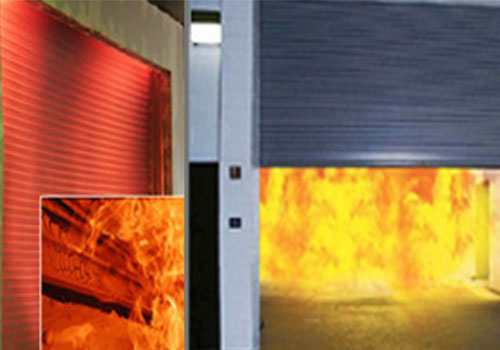Any large public, commercial, or industrial building with a fire prevention and escape plan could benefit from fire shutters. Specially designed, these shutters can save lives and limit the damage caused by spreading flames and smoke if a fire breaks out on the premises.
If you need to know more about how fire shutters can help, this blog explains what exactly they are, how they work, and what you should do if your building needs fire shutters.
What is a fire shutter?
Just as a standard metal roller shutter can be installed over windows and doors as a security barrier, a fire shutter can be fitted at a high-risk point in the building’s layout as a fire barrier.
They’re usually found in places such as kitchens, labs, and storage areas that may contain flammable materials, which may need to be cut off from the rest of the property quickly if a fire starts.
This type of shutter is made to be fire-resistant, so that when it rolls down, it can hold back the heat and smoke of a fire for a period of time. This helps to contain the fire, hopefully long enough for firefighters to arrive on the scene and extinguish the flames before they spread any further.
Even if it’s only 30 minutes, this can make a huge difference in allowing people to evacuate the building and limiting property damage. Most fire shutters will have an integrity and insulation rating of at least EI60, meaning that the barrier should hold out for a minimum of 1 hour.
Made from solid laths of thick galvanised steel, fire shutters are fitted to openings up to 12 metres wide, in masonry or structural steel that must meet the same fire rating standards as the shutter.
The minimum standardised requirements for fire resistant shutters are set out in the British/European standards 16034:2014 and 13241-1:2014 + A1:2018.
How do fire shutters work?
Usually, fire shutters will stay rolled up out of sight until they are triggered to drop, either by a wider fire alarm system that they’re connected to or by the shutter’s own heat/smoke detectors. When activated, fire shutters will close off passages between parts of the building, creating compartments and preventing the fire from spreading between them for as long as possible.
They work alongside other fire safety measures like smoke alarms and sprinklers to alert people to the fire and attempt to contain it until emergency services teams can get there to tackle it.
There are different types of fire shutter operating systems available, with different control settings according to how you want the shutters to respond to certain triggers. For example, they could drop closed immediately upon receiving a volt-free signal from the building’s fire alarm system, or drop partially and only close completely when the door’s sensor detects an excessive temperature.
In the latter case, the opening can still be used as an escape route for as long as possible until the fire approaches the barrier point. Since the shutter will be half-closed, it can still hold back hot smoke and toxic fumes that rise towards the ceiling during this time. This is crucial, considering the most common cause of death in fire fatalities in the last year was ‘overcome by gas or smoke’.
Since blackouts could happen at any time, and electrical power failures are possible during fires, every fire shutter must also have a fail-safe operating system built-in – such as a back-up battery, a manual hand-crank, or an automatic release upon loss of power.
Does your business need fire shutters?
Fires in non-dwelling buildings account for 20% of serious fires in England – so, while most fires and related fatalities occur in homes, there’s still a significant danger for non-residential premises.
In cases from the last year (2021-2022) where the whole building was damaged by fire, this happened the most to agricultural and industrial premises. However, more fires in industrial buildings were limited to the floor the fire started on, and even more to the original room.
In fact, the average square metreage of damage from fires in non-dwellings decreased by 16% in the last year alone – compared to 17% less than 5 years ago and 27% less than 10 years ago.
Could this be due to more businesses taking fire safety seriously and investing in stronger measures like fire shutters? The government doesn’t draw any conclusions from their published statistics, but the downward trend in damage and fatalities for non-dwellings indicates that businesses and non-residential property owners are doing something different to increasingly minimise the risks of fire.
Whatever the case may be, we all know that minutes and even seconds can make a huge difference in stopping the spread of fire and saving lives. The right fire shutter, professionally installed and regularly maintained, could be invaluable in keeping your property and people safe from fire.
If you’re ready to invest in fire shutters for your business, be sure to search for a reputable supplier in your area – such as a provider of roller shutters in Bolton – who can not only help you with fire shutters that fit your specifications perfectly, but also offer ongoing maintenance services for them.































